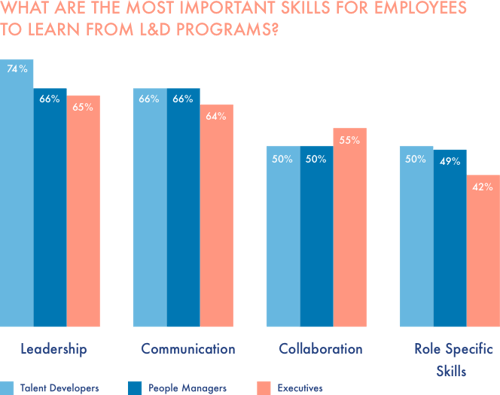By Paola Pascual on Oct 27, 2021 3:16:24 PM
Keeping up with the pace of technological advancement used to be a major challenge for organizations. Today, that is only one of them. The Great Resignation, the current war for talent, a post-pandemic workplace, and constant market changes keep adding up. The cost of talent acquisition continues to increase and the demand for specialized and technical skills is seeing a rapid rise.
How can organizations handle this constantly changing environment? According to McKinsey, “to emerge stronger from the COVID-19 crisis, companies should start reskilling their workforces now.” Reskilling and upskilling your workforce will help you develop a successful upward mobility program that has the potential to increase your resilience and adaptability to current changes.
What is upward mobility?
Upward mobility, in economic and social terms, is the capacity or facility that individuals have to rise to a higher position. Increased upward mobility is generally a sign of an equal, free society. It means that a person is less hindered by their socioeconomic status at birth.
When we talk about upward mobility within the context of employment and Human Resources, we refer to how easy –or difficult– it is for employees to advance in their careers.
If you hire senior management from within your organization and your employees are able to progressively acquire more responsibility, then it would be fair to say that your organization offers great potential for mobility. The opportunity to get promoted or “climb the ladder” plays a major role in employee retention and engagement.
3 Steps to developing a successful upward mobility plan
Offering opportunities for employees to grow in your organization will benefit your company in many ways –your people will stay longer, workplace changes will be easier to handle, employee engagement will go up, and you will save time and money in recruiting. When crafting a successful upward mobility plan, consider the following three steps.
#1 Hire from within
Internal hiring (also known as internal recruitment) refers to the process of sourcing and hiring existing employees for open roles. If the person already passed your interview process once, they must have done something well, right? Here are some of the many benefits of internal hiring:
- Strong culture fit
- Reduced hiring costs
- Increased employee motivation, engagement, and morale
- Easier onboarding process
- Decreased turnover rate
Upward mobility should happen fast (as fast as it makes sense business-wise). Keeping employees hanging, waiting long months to get promoted will undermine their morale and encourage them to look for advancement elsewhere. On the contrary, swift mobility and opportunities for growth will increase morale and keep employees engaged.
Understand that workers move in well-defined patterns and, based on their characteristics and occupations, they will transition to other roles according to those boundaries. Make sure that the pathways to advancement not only exist but are also wide and free of hurdles.
- Lay down a specific set of policies for recruiting internally
- Shortlist and call in a few internal candidates instead of assigning the role to a specific individual
- Establish a clear succession plan
- Make the information known to all your employees (circulate the vacancies across different channels)
#2 Offer training and development programs
A successful upward mobility program involves providing training, career development, and growth opportunities to those employees with talent and potential whose current situation does not allow for further advancement. Leverage training programs to offer your workforce viable opportunities for development. Identify and address gaps and barriers and help your employees reach their full potential with learning opportunities tailored to those needs. Look at the skills that are essential for their role and situation, and help your workers develop them through mentoring and training. And not only that, encourage them to shift roles, projects, and assignments and provide them with the tools they need to develop the skills they’re missing.
Research from LinkedIn shows a change of focus from “hard” skills to “soft” skills. Jeff Weiner, LinkedIn CEO, concluded, “Somewhat surprisingly... Interpersonal skills are where we’re seeing the biggest imbalance. Communication is the No.1 skills gap.” Train your workforce on all the essential skills they need and do not underestimate the importance of soft skills, as these are critical skills required to succeed in the modern workplace.
- Foster a culture of continuous learning
- Offer mentoring programs
- Get managers involved
- Focus on training for soft skills, particularly communication and leadership skills
- Suggest specific training programs and allow them to pick their own
 Source: LinkedIn Learning
Source: LinkedIn Learning
#3 Cultivate an inclusive company culture with a growth mindset
A thriving culture is one that’s both encouraging and challenging. Fostering a culture of continuous improvement and growth will help you implement an upward mobility plan successfully and also make your organization more agile. Don’t assume that talent is innate. We don’t need to be born with it. Instead, we can develop it through effort, encouragement, dedication, and feedback.
Be mindful of the mobility gaps that exist across wage level, industry, race, gender, and physical abilities (these gaps still hold some workers back). Underrepresented minorities are often faced with fewer opportunities for career development, and this not only leads to an unsafe work environment, but it will also hinder your upward mobility plans. Your organization's mindset will help you boost diversity and inclusion in your workplace, which truly is a competitive advantage when it comes to upskilling and upward mobility.
Bottom line
Establishing successful upward mobility programs will make your organization more resilient and adaptable to the current market needs. Here are some signs that you're doing a good job...
- There’s easy access to leadership within your organization
- The pathways for advancement are equally accessible to people regardless of their gender, race, physical abilities, political views, sexual orientation, age, or race
- Your leadership pool is diverse
- Your employees listen to and act on constructive feedback
- Some of your current managers were hired through internal recruitment
- You have filled some vacancies with some of your existing employees
- Your employees feel comfortable asking for training opportunities
- Your workforce participate in the learning programs offered by your organization
- You clearly see that your employees are applying what they've learned to their day-to-day jobs
Next steps
At Talaera, we are committed to helping organizations with their upskilling efforts. We work hand-in-hand with managers to assess and identify skills gaps and to create personalized programs just for them. Contact us and we will build the right program for your teams... Whether it may be 1:1 support for new managers to have difficult conversations, workshops to learn how to give more engaging presentations, or a company-wide webinar to improve internal communications on Slack. Learn more here.
Interested in getting the best offers and receiving free content on Business English communication? Subscribe to our newsletter and we will keep you in the loop with offers, free events, and learning materials!
Continue reading:
- How To Boost Employee Engagement - You Need To Look At These 5 Things
- How To Manage Language and Cultural Diversity in The Workplace
- 4 Tangible Benefits of Having a Diverse Workforce
- 8 Companies With Great Company Culture Examples
- 4 Examples of How Companies Effectively Engage Their Employees
- Top 5 Perks Employees Enjoy at a Multinational Company
- 150+ Useful Email Phrases That Will Make Your Life Easier




comments